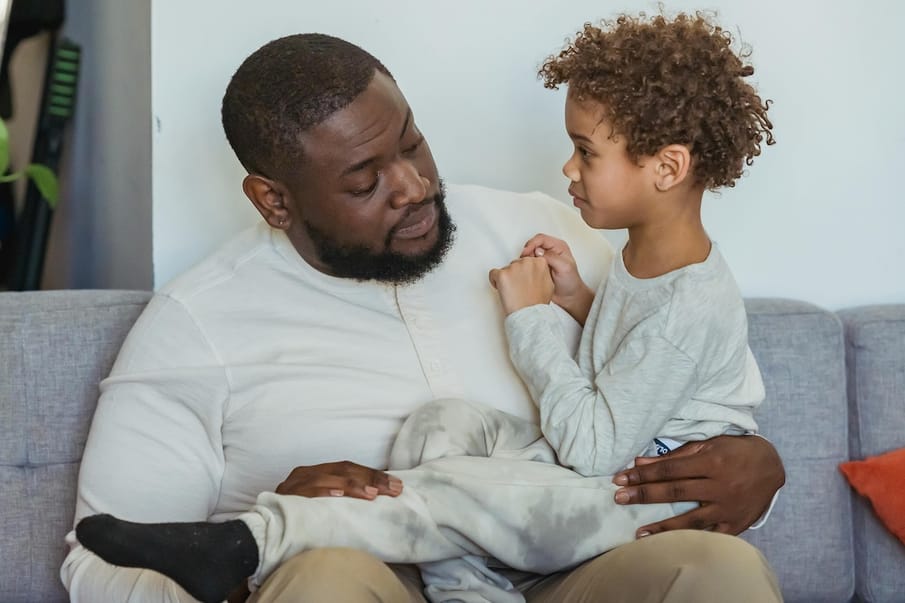It’s natural to want to shield children from bad news, but sometimes we need to have tricky conversations. Whether it’s unexpected news or ill health, sharing difficult news is never easy, but here are five tips to help you navigate it…
When it comes to parenting, the thought of upsetting our child by sharing bad news can be hard to bear. As much as we want to make their world as care-free as possible, life can get in the way. Whether it’s change (such as a relocation or separation), illness, or even death, sometimes we have to have difficult conversations, whether we like it or not. While you might not be able to change the news or circumstances, you can change how you talk about it. Here are five tips to help you get it right…
1. Plan your words carefully.
Think carefully about how you deliver the news; you know your children best, so it’s all about making sure they can understand and process the information you give them.
“Use appropriate language and communication for the age of the child/children involved,” says therapist Fiona Van Zyl. “Deliver explanations using vocabulary they can access that is appropriate for their developmental level. Being clear and concise is also important to avoid any ambiguity and misunderstandings, as these can cause additional stress for children.”
At the same time, stick to the key parts of the news. “Avoid overwhelming them with too much information,” adds person-centred counsellor Lianne Terry.
2. Model good coping strategies from the get-go.
Remember that your child is looking to you to understand how to express and cope with difficult emotions, so show them the way. “Ensure that your child knows that they can express their feelings; children learn by example, so demonstrate healthy coping strategies yourself, through talking about and expressing your feelings, engaging in soothing activities, or seeking support from friends and family,” says Lianne. “Let your child know that whatever they feel is completely acceptable, and allow them to express their thoughts and feelings openly without judgement.”

3. Pick the right moment.
There’s never a good moment to deliver bad news, but a little bit of planning can make a difference. It’s best not to blurt it out, but creating the best environment for sharing tough news can help.
“Create a safe space in which to share the news. Generally, this will be a quiet, comfortable space, where you can talk without distraction,” says Lianne. “Make sure you are completely in the moment with them, without feeling rushed or distracted.”
Therapist Fiona highlights how the setting for your conversation can play an important role, too. “Consider the setting – a place that is familiar and where the child/children is/are likely to feel comfortable and safe. Bear in mind a routine that you and your children have when it comes to talking about things that are important to them. For example, if you often have conversations while sitting on the sofa, or in the garden and so on, it can be helpful to replicate this when delivering confronting news.”
4. Build in reading time.
One way to help children understand new situations is by reading about it – whether that is through books to help them understand certain emotions, or tackle certain types of tough circumstances. Your library can be a great starting point, but Lianne Terry has some specific recommendations as well.
“Some brilliant books that can help when sharing bad news with your child include: The Invisible String by Patrice Karst (helpful for children dealing with separation anxiety, grief and loss); The Colour Monster by Anna Llenas (a gentle exploration of feelings for children); Cancer Hates Kisses by Jessica Reid Sliwerski (a gorgeous tool to help navigate difficult conversations about cancer with children); and Elmer and the Gift by David McKee (talks about caring for elderly family members).”

5. Honesty is the best policy.
It’s easier said than done, but trying to be as honest as you can be with children is important. “Children feel more unsafe if they pick up that adults are not being honest with them, or if it is later revealed that they were not initially told the truth,” explains Fiona. “It is understandably tempting to want to use euphemism or fabrication to protect young people, but this can have the reverse effect. Provide facts, but reflect on your delivery of these.”
While every child is different, hopefully our expert tips have given you a starting point to navigate sharing bad news with children. Like always, you know your child best, but taking time to consider the time and place you communicate, along with your choice of words, and the support you offer, will make a real difference in helping your child come to terms with challenging circumstances.


Comments